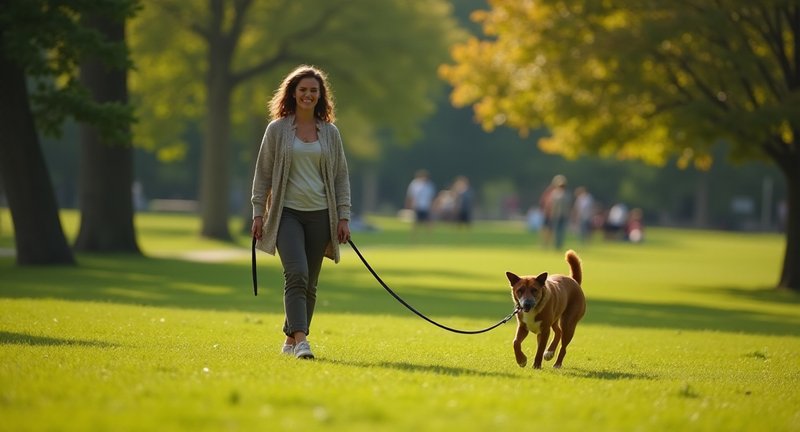An Introductory Look at Long Lead for Dogs
When I first heard about using a ‘Long Lead for Dogs,’ I admit, I wasn’t sure if it was the right tool for my pup. But after some trial and error, I can confidently say it’s become an essential part of our outdoor adventures. Think of a long lead as a happy medium between total freedom and keeping your dog on a tight leash. You get control, and your dog gets room to explore.
Now, for those who are new to it, let me break it down. A long lead typically ranges from 15 to 50 feet and allows dogs the freedom to roam without the fear of them wandering off. It’s perfect for activities like:
- Training recall: You can practice calling your dog back from a distance without completely letting them loose.
- Exploring safely: Whether you’re at the beach or a park, your dog gets to sniff and explore while you still maintain control.
- Transitioning to off-leash: If you’re unsure about letting your dog off-leash, a long lead is a great in-between step to test the waters.
But here’s the thing using a long lead takes some getting used to. You need to be mindful of tangling (both for you and your dog) and learn how to smoothly reel in and let out the slack. Also, it’s best used in open areas where your dog can move freely without obstacles.

To sum it up, the ‘Extended leash for dogs’ can be a game-changer for training and outdoor fun. It offers the best of both worlds freedom for your dog and peace of mind for you.
Why a Long Lead for Dogs Is Essential
From my experience, one of the best tools to give your dog more freedom while keeping control is, without a doubt, an extended leash. It’s something every dog owner should have in their toolkit, especially for training and outdoor adventures.
Why does it matter so much? First, it allows your dog to explore further while you stay in control. Imagine taking your dog to a park or an open field. They can sniff and wander around without the constant tugging on a short leash, but you still have the ability to pull back when necessary. It gives your dog a sense of freedom, but without the risks that come with complete off-leash adventures.

Another great aspect is how it helps with training. When working on recall, you need to teach your dog to return to you from a distance. With an extra-long leash, you can gradually increase the distance they wander, building that skill slowly and safely.
Here are a few reasons why this type of leash is a game changer:
- Improved Safety: Whether you’re hiking, walking through a new neighborhood, or even just at the beach, you can prevent your dog from bolting after a distraction.
- Greater Exploration: It lets your dog roam more freely, giving them a chance to enjoy their surroundings and stimulate their senses.
- Training Benefits: If you’re focusing on commands like “come” or “heel,” having that extra distance can make your training more effective.
- Confidence Building: For nervous or timid dogs, having more space to explore can increase their confidence while still knowing they’re secure.
This type of leash is an absolute essential if you want to balance freedom and safety for your dog’s outdoor adventures.
Understanding the Importance of Dog Leads
Concerning walking dogs, a lead isn’t just a practical tool it’s the lifeline of your connection with your furry friend. I’ve always found that using a proper dog lead is like giving both of us the freedom to explore, but in a safe, controlled way.
A good lead offers balance. Your dog gets to satisfy that wild urge to sniff every inch of the world, and you don’t lose control. It’s amazing how just a piece of material can open up this channel of trust and communication between you and your pet.
If you’ve ever walked a dog without the right lead, you know how chaotic things can get. Too short, and it feels restrictive. Too long, and you’re wrestling with a bundle of chaos. Finding that sweet spot is where the magic lies.
I often think of a lead as more than just a length of leash; it’s a way of creating boundaries that protect our dogs from the dangers they don’t always see. Whether it’s keeping them from running into traffic or simply staying close when distractions are everywhere, the lead becomes a safety net.
Choosing the right lead can feel a bit overwhelming. There are so many types out there, but understanding your dog’s personality and the environments you’ll be in makes all the difference. In my experience, having a reliable lead really changes the entire walking dynamic.
What is a Long Leash for Dogs?
Concerning giving my dog some freedom while keeping control, I reach for a special kind of leash. It’s not the typical short one you use for casual walks in the park. This is for those moments when you want your dog to explore but still need to guide their journey.
Think of it as a leash with room to breathe. It’s longer than what most people expect, offering a sense of space for both me and my dog. Whether we’re at a wide-open field or a forest trail, it allows him to wander a bit further from me without letting him roam wild.
What I love about this leash is the balance between safety and independence. My dog gets to sniff around, chase a scent, or simply enjoy a good run, and I can still reel him back in when needed. It’s like letting your dog enjoy the best of both worlds – adventure and supervision.
I’ve found it particularly helpful for training too. When teaching recall or practicing commands in a larger space, this leash acts as a gentle boundary, a subtle reminder that I’m still here, even when he thinks he’s off on his own.
Trust me, it’s a game-changer for those days when a fenced yard or tight city streets just won’t cut it. It’s the perfect tool for dog owners who want to let their pets explore but aren’t quite ready to let them off-leash entirely.
Benefits of Using a Longer Leash
As for enjoying the great outdoors with our furry companions, I’ve found that utilizing a longer leash can truly elevate the experience for both of us. Trust me; the advantages are plentiful!
First off, a longer leash grants your dog the freedom to explore. Picture this: your pup can venture a little further into the grass, sniff that intriguing tree, or greet a friendly passerby without feeling confined. This sense of autonomy not only makes walks more enjoyable but also boosts their confidence.
Here are a few benefits I’ve noticed from using an extended leash:
- Enhanced Exploration: With more space to roam, dogs can engage their natural curiosity, which is essential for their mental stimulation.
- Improved Training Opportunities: A longer line can aid in training sessions, allowing your dog to practice recall and other commands while still having some freedom to explore.
- Reduced Stress: When dogs feel they have more control over their environment, they are generally less anxious. A longer leash can help alleviate that pull you sometimes feel from an excited pup.
Of course, it’s important to maintain control and ensure safety. Choosing the right length based on your environment is crucial too long in crowded areas can lead to tangles or accidents. It’s all about balance.
So, the next time you grab your walking gear, consider reaching for that longer leash. You might just find it transforms your outings from mundane to magical, creating a delightful bond with your canine friend.
Enhancing Training with Extended Leads
When I first ventured into the substance of dog training, I discovered a nifty tool that would revolutionize my sessions: extended leads. These flexible tethers became my secret weapon for enhancing my furry friend’s training experience.
With a longer line in hand, I found the freedom to explore vast training landscapes. My pup could roam, sniff, and discover, all while remaining under my watchful eye. It was like giving them a taste of independence without losing control.
One of my favorite moments was at the park. Picture this: my dog bounding through the grass, chasing butterflies while I stood confidently at a distance. The extended lead allowed me to teach them recall in a real-world setting, rather than just the confines of my backyard.
Incorporating this tool has truly transformed our outings. It allows for spontaneous bursts of fun while reinforcing essential commands. The joy of watching my dog frolic freely, knowing they can be reined in at any moment, is simply unmatched.
Also, let’s not forget the safety aspect. When we’re in busy environments, that extra length ensures my pup isn’t inadvertently wandering into trouble. It creates a buffer zone that keeps our training sessions positive and stress-free.
So, if you’re looking to add a dash of excitement and flexibility to your training routine, consider embracing this game-changing accessory. It might just be the spark you need to light up your training adventures.
Safety First: Keeping Your Dog Secure
As a devoted dog owner, I’ve learned that ensuring my furry friend’s safety is paramount. One of the best tools I’ve discovered in my journey is the Long Lead for Dogs. This handy device allows my pup to roam while still keeping them within reach.
Imagine a picturesque day at the park. My dog, tail wagging and eyes bright, dashes after a butterfly. With a Extended dog leash, I can let them explore without the constant worry of them sprinting off into the sunset. It’s like giving them a taste of freedom while holding onto the safety tether.
Now, let’s chat about the peace of mind it brings. Having a Dog tethering lead means I can enjoy those lovely, lazy afternoons without a constant barrage of anxiety about nearby traffic or potential distractions. It’s a simple tool that transforms our outdoor adventures into delightful escapades.
What I appreciate most is the variety available. Some leads come in bright colors or even with reflective materials, making them not just functional but also stylish. It’s all about that blend of safety and personality.
Whether at the park or on a hiking trail, I’ve found that using a Adjustable dog lead encourages my pup to engage with their environment while still ensuring they’re close by. It’s an easy way to keep our bond strong while allowing for exploration.
Remember, when it comes to our furry companions, a little extra security goes a long way. So, if you haven’t yet, consider investing in a Flexible lead for pets. It might just be the key to unlocking more joyful moments together.
Exploring the Outdoors with Your Dog
Taking my dog on outdoor adventures has always been one of my favorite pastimes. The fresh air, the rustling leaves, and the joy of sharing new experiences with my furry friend create unforgettable memories. If you’re considering taking your pup on an outdoor expedition, here are a few things I’ve learned along the way.
1. Choose the Right Gear
- Comfortable Harness: Ensure your dog wears a harness that fits snugly but isn’t restrictive. A good harness distributes pressure evenly and provides better control.
- Hydration Essentials: Pack a portable water bowl and plenty of fresh water to keep your pup hydrated. Dogs can get just as thirsty as we do on a hot day.
- Safety First: Consider a reflective vest or collar if you plan to be out during dusk or dawn. This makes it easier for you to spot each other!
2. Find Dog-Friendly Trails
- Seek out trails that welcome dogs. Websites and apps can help you discover local parks or hidden gems in your area.
- Pay attention to leash laws; some areas require pets to be on a leash at all times. Others might have designated off-leash zones for your dog to run free.
3. Observe Nature Together
- Encourage your dog to explore different scents and sights. It’s amazing to see the world through their eyes every stick is a potential treasure!
- Take breaks to enjoy the scenery. Sit down, have a snack, and let your dog soak up their surroundings. You might find a shared moment of tranquility that’s hard to beat.
Every outdoor excursion is a chance to bond and create stories that both you and your pup will cherish. So, pack your gear and set off on a grand adventure!
Long Leashes vs. Standard Leashes: A Comparison
When it comes to choosing the right leash for our furry friends, the decision between extended leashes and standard ones can feel like standing at a fork in the road. I remember the first time I tested out a longer leash; it felt like opening the floodgates to a whole new world of exploration for my dog.
Longer leashes offer a tantalizing sense of freedom. They allow dogs to roam, sniff, and discover the world around them without the constant tug of a shorter line. However, I quickly learned that with this freedom comes a bit of responsibility. You’ll need to keep an eye on your pup to avoid any mischievous escapades into nearby bushes or, heaven forbid, busy streets.
On the other hand, standard leashes provide a tighter grip on the situation. There’s a certain comfort in knowing exactly where your canine companion is at all times. With these leashes, I felt more in control during training sessions or when navigating crowded areas, reducing the chances of an unexpected dash after a squirrel.
It’s worth noting the benefits of each option. Longer leashes can be fantastic for open spaces, allowing dogs to stretch their legs and satisfy their natural curiosity. Yet, when it comes to city walks or tight spaces, a standard leash shines brighter than a diamond in the rough.
Also, the choice between these two types boils down to lifestyle and environment. Think about your surroundings and your dog’s personality before making a decision. In the end, it’s about finding the perfect balance between adventure and safety.
Choosing the Right Length for Your Needs
With respect to selecting the ideal length for your dog’s leash, it’s not a one-size-fits-all scenario. Drawing from my own experiences, I’ve found that the right length can transform a simple walk into an adventure. Here are some factors to consider:
-
Purpose of Use
- Daily Walks: For regular strolls around the neighborhood, a standard leash length of around 4 to 6 feet provides excellent control while allowing your furry friend some freedom to explore.
- Training Sessions: If you’re ascertaining obedience training or teaching your dog specific commands, a shorter leash (around 2 to 3 feet) can enhance your control and facilitate more effective communication.
- Exploratory Adventures: On the flip side, if you’re venturing into open spaces or parks, a longer leash can offer your dog the thrill of exploration while still keeping them safe and manageable.
-
Dog’s Size and Behavior
- Smaller Breeds: Tiny pups may benefit from shorter leashes, ensuring they remain close and avoid unexpected confrontations with larger dogs.
- Energetic or Large Dogs: For these spirited companions, longer leashes can provide them with the space they crave, but be cautious about tangling and unexpected sprints.
-
Terrain Considerations
- Urban Areas: Navigate crowded streets with a shorter length to maintain control and prevent surprises.
- Natural Settings: In open parks or hiking trails, a longer leash can enhance their sense of freedom while you keep an eye on their antics.
Also, the leash length you choose should cater to your unique needs, your dog’s behavior, and your walking environment. Happy exploring!
Materials and Durability of Extended Leads
When dealing with exploring the great outdoors with our furry friends, the materials and durability of extended leads play a pivotal role. I’ve experienced firsthand how a flimsy lead can turn a serene walk into a stressful tug-of-war.
Choosing the right material is akin to selecting the best gear for an adventure. I’ve found that nylon and leather both offer unique benefits. While nylon is lightweight and often comes in vibrant colors, leather boasts a timeless appeal and can withstand wear and tear. The feel of leather in my hand brings a sense of reassurance, like holding onto a piece of history.
Durability is non-negotiable. Imagine trekking through rugged trails or navigating through busy parks your lead needs to endure it all. I remember a particularly memorable hike where I had to scramble over rocks; my nylon lead held up beautifully, proving its mettle against the elements.
Another factor I can’t overlook is the stitching. The craftsmanship behind the seams can make all the difference. When I chose a lead with reinforced stitching, it felt like a hidden insurance policy one I’m grateful for during those moments of excitement when my pup decides to chase after a squirrel.
Also, consider the clasp. I once had a lead with a weak clasp, and let’s just say, that was a heart-stopping moment! A robust and reliable clasp not only gives peace of mind but also enhances the overall experience.
As I continue to explore new trails, I’m reminded of how essential it is to invest in quality materials. They truly make every outing safer and more enjoyable, allowing me to focus on the joy of adventure rather than worrying about the gear.
How to Properly Use a Long Leash
When it comes to giving our furry friends the freedom they crave while still maintaining control, using an extended leash can be a game changer. In my experience, it’s all about finesse and a touch of patience. Here’s how to wield this tool effectively, ensuring both you and your pup enjoy the adventure.

1. Choose the Right Length
- Standard Lengths: A leash between 15 to 30 feet is typically ideal. It allows ample room for exploration while still being manageable.
- Environment Matters: If you’re in a crowded park, opt for a shorter length. In open spaces, you can let your dog stretch their legs a bit more.
2. Mind Your Grip
- Hand Positioning: Keep your hands firmly but gently on the handle. A relaxed grip helps absorb sudden pulls.
- Two-Handed Technique: For extra control, especially with energetic dogs, use both hands to maintain balance and reduce strain on your wrist.
3. Watch for Signals
- Observe Body Language: Your dog’s posture can tell you a lot. If they’re lunging toward something, be ready to step in.
- Stay Attentive: Keep your focus on your surroundings. Watch for obstacles and other dogs to prevent any surprises.
4. Practice Recall
- Command Training: Before going out, ensure your dog knows basic commands. Consistent practice makes all the difference when it counts.
- Reward Good Behavior: Use treats or praise to reinforce positive actions when they respond to your call.
5. Enjoy the Freedom
- Allow Exploration: Let your dog sniff, wander, and play. This is their time to soak in the world.
- Take Breaks: Give them a moment to rest and recharge. It keeps the adventure fun and engaging for both of you.
Using an extended leash is an enriching experience that nurtures the bond between you and your canine companion. Just remember, with great freedom comes great responsibility.
A Thorough Examination of Long Lead for Dogs
As a devoted canine enthusiast, I often find myself reflecting on the remarkable advantages of using extended leashes. There’s something liberating about watching a furry friend frolic in the great outdoors, exploring the world at their own pace while still being under my watchful eye.
These versatile tools open up a realm of possibilities. Whether it’s a leisurely stroll through the park or an invigorating hike, the additional length allows our dogs to enjoy a sense of freedom. They can sniff out interesting scents, engage with their environment, and stretch their legs without feeling confined.
I remember my first experience with one of these extended tethers. I was initially a bit apprehensive, worried about tangles and the potential for mischief. But, to my surprise, it transformed our outings into delightful adventures. My pup darted from tree to tree, chasing butterflies while I savored the moment, knowing I could reel them in when needed.
Moreover, they are excellent training companions. Teaching recall and obedience becomes an engaging game. Instead of a strict tug on the collar, there’s a gentle encouragement, allowing our furry pals to feel empowered while still learning essential commands.
In my opinion, the joy these tools bring to both dog and owner is priceless. It fosters trust and deepens the bond we share, reminding us both that exploration is best enjoyed together. So, if you haven’t ventured into the nature of extended tethers, I encourage you to give it a try. You might just discover a new layer of joy in your outdoor escapades.
The Role of Extended Leads in Recall Training
The journey of teaching a dog to come when called can be both exhilarating and frustrating. One of the most enlightening tools I’ve stumbled upon in my adventures of dog training is the use of extended leads.
Imagine this: your dog is frolicking in a field, nose to the ground, living their best life. With an extended lead, you have the ability to give them the freedom to explore while still maintaining control. This balance can turn a simple walk into a delightful game of chase and return.
From my experience, these longer leads transform recall training into a positive experience. The added distance allows for a more engaging interaction, where your dog learns that coming back to you doesn’t mean the fun is over. Instead, it can be the gateway to even more exciting adventures.
Moreover, extended leads are perfect for building confidence in shy or hesitant pups. When they feel secure in their surroundings but still have that safety tether, they begin to realize that the world isn’t as daunting as it seems. I’ve witnessed timid dogs blossom into enthusiastic explorers simply because they felt a sense of security.
It’s crucial, however, to use these leads mindfully. A sudden jerk or tension can lead to confusion or even fear in your furry friend. The key is to keep things light and fun, reinforcing the idea that returning to you is just as thrilling as the exploration itself.
So, if you’re venturing into the point of recall training, consider the magic of extended leads. They might just be the secret ingredient in your training recipe, fostering a bond built on trust and adventure.
Reducing Anxiety in Dogs with Longer Leashes
I’ve found that one of the easiest ways to help reduce anxiety in dogs, especially when they’re out and about, is by giving them more room to explore. Instead of the usual short leash, offering your dog extra freedom to roam can do wonders for their mental state. It’s almost like giving them the chance to sniff out their surroundings without feeling too restricted.
Here’s why a longer leash can be a game changer for anxious pups:
- Sense of control: Dogs feel more at ease when they can move away from things that make them nervous. With a little extra leash, they get to choose their distance, which helps them feel safer.
- More freedom, less pressure: A tighter leash can unintentionally create tension, which your dog can sense. By allowing some slack, you’re reducing that pressure and giving them a chance to relax.
- Sniffing time: We often underestimate how much a dog relies on their nose to make sense of the world. Allowing them to spend more time sniffing around can keep their mind engaged and reduce stress.
- Gradual exposure: If your dog is anxious around new places or people, this method lets them decide how close they want to get, helping to ease them into unfamiliar situations at their own pace.
It’s amazing how much of a difference it makes. Just a little extra space can mean the world to a dog who’s feeling overwhelmed. And really, the best part? It’s such a simple adjustment for us as dog owners.
Frequently Asked
Are long leads good for dogs?
Yes, long leads can be great for dogs, especially when it comes to providing them with more freedom while still maintaining control. They allow dogs to explore their environment at a comfortable distance without the risk of running off or becoming too far from the owner. This can be particularly beneficial in open spaces like parks or fields, where dogs can enjoy a more natural and stimulating environment. Long leads are also helpful for training purposes, such as teaching recall commands.
How long should a dog’s long line be?
A dog’s long line typically ranges between 15 to 30 feet, depending on the purpose and the environment. For basic training or regular walks in controlled spaces, a 15 to 20-foot long line may suffice. However, for more expansive environments where dogs can roam further, a longer line of 25 to 30 feet might be better. It’s essential to choose a length that allows the dog to move freely while ensuring you can still control them effectively when needed.
What is the benefit of a long leash?
The main benefit of a long leash is that it gives dogs a greater sense of freedom while keeping them under control. It encourages natural behaviors such as sniffing and exploring, which can lead to better mental stimulation and satisfaction during walks. Long leashes are also useful for training recall and obedience skills, as they allow the dog to distance themselves while still being safely tethered. This type of leash can enhance the overall walking experience for both the dog and the owner.
Are extending dog leads safe?
Extending dog leads can be safe when used correctly, but they do come with potential risks. If not properly managed, they can cause entanglement, sudden jerks, or lack of control, especially in high-traffic areas. Additionally, dogs on extending leads may run into dangerous situations, such as crossing streets or approaching other animals. To ensure safety, extending leads should be used in open, less crowded spaces, and the owner must remain attentive and able to retract the leash quickly if necessary.
Is it OK to walk your dog on a long leash?
Yes, it’s perfectly fine to walk your dog on a long leash, as long as you use it in appropriate environments. Long leashes are ideal for wide-open spaces, where your dog can safely explore without getting too close to potential hazards, like traffic or other dogs. However, they might not be suitable for congested areas, such as busy sidewalks or city parks. When using a long leash, always stay alert and ensure you’re able to control your dog at a moment’s notice.
What is the best lead to stop a dog pulling?
The best lead to stop a dog from pulling is typically a shorter leash combined with a no-pull harness. While long leads offer freedom, shorter ones give more control, making it easier to manage a dog that pulls. Pairing this with a harness designed to distribute pressure evenly can help discourage pulling without causing harm to the dog. Proper training, using techniques like rewarding calm walking behavior, is crucial to effectively stop pulling in the long term.
What is the best length for a dog leash?
The ideal length of a dog leash depends on its intended use. For casual walks or training in populated areas, a leash between 4 to 6 feet long offers optimal control and safety. Longer leashes, such as those around 15 to 30 feet, are better suited for open spaces where the dog can roam and explore without getting into trouble. The leash should give the dog enough room to be comfortable while ensuring you can maintain control over their movements.
Is a 10 foot leash too long?
A 10-foot leash can be too long for everyday walks in crowded areas but might be perfect for more relaxed environments like parks. It provides more freedom for dogs to explore than standard leashes but still allows for better control than extremely long lines. However, in high-traffic areas or places with many distractions, a shorter leash would offer more safety and control. A 10-foot leash strikes a balance for those wanting to give their dog a bit more freedom in less risky settings.
What leads do dog trainers recommend?
Many dog trainers recommend leashes that provide both control and flexibility depending on the dog’s training level. For basic obedience training, a 6-foot leash is often suggested as it offers ample control without restricting movement too much. Long lines, ranging from 15 to 30 feet, are commonly recommended for recall training and off-leash simulations. Trainers also often advocate for durable, non-retractable leads made from materials like nylon or leather for safety and durability.
How do you walk a dog on a long lead?
Walking a dog on a long lead requires practice and attention. To start, ensure you have a comfortable grip on the leash and allow your dog to gradually move further from you. Use verbal commands to keep your dog engaged and check in regularly to ensure they don’t get too far or tangled. Keep the leash from dragging on the ground to avoid tripping, and be ready to reel it in quickly if needed. In busier areas, it’s best to shorten the lead temporarily for better control.











I couldn’t agree more with your love for outdoor adventures with dogs! There’s nothing quite like exploring nature together. Your tips on choosing the right gear are spot on! I always make sure to bring a portable water bowl too; it keeps my pup refreshed, especially during those long hikes. Reflective vests are a lifesaver for early morning walks, and I can’t tell you how many times it has helped us stay visible during dusk. Thanks for the reminder to find dog-friendly trails! Happy adventuring!
I absolutely relate to your experience with the Long Lead for Dogs! It’s like giving our pups a little taste of freedom while ensuring they’re safe at the same time. I remember the first time I used one at the beach; my dog was over the moon chasing seagulls and exploring the sand without me having a mini panic attack every time he darted off. It’s such a game-changer for those lazy park afternoons too! It’s fascinating how something as simple as a tethering lead can enhance our time outdoors together. Plus, I love the variety available now! I recently found a neon one that not only keeps my pup safe but also looks super cool on him. Safety with a splash of style is always a win! I can’t agree more with your point about the bond it creates. My dog seems happier and more relaxed knowing he has that space to explore. Your article perfectly captures that balance of freedom and security that every dog owner strives for! So true investing in a flexible lead is definitely wo
Your experience with extended leads is so relatable! I had a similar revelation when I started using one for training sessions. It’s like a magic wand for dog training! Watching my dog run freely while still being connected is a joy that’s hard to beat. It’s incredible how such a simple tool can open up a whole new world for both of us. I totally agree that the safety aspect is crucial, especially in busy areas. That extra length gives me peace of mind knowing my pup has room to play without getting into trouble. Thanks for sharing these insights! I’m inspired to take my dog out for some more training fun this weekend!
I love how you highlight the benefits of using a longer leash for outdoor adventures! It’s so true letting our furry friends roam a bit can really boost their confidence and happiness. I’ve seen my dog transform from a shy little thing to a curious adventurer simply by giving him that extra bit of freedom. Plus, it’s fascinating to see how it impacts their behavior! They become more engaged and relaxed, which is a great relief for us owners too. Your point about the balance is spot on; it’s all about finding that sweet spot between freedom and control. I’ve had my fair share of tangles in crowded areas, so I completely get where you’re coming from! I always make sure to assess my surroundings before heading out with that longer leash. The rewards are so worth it, though! Next time I gear up for a walk, I’ll definitely be more mindful of that leash. Thanks for sharing your experience; it’s such a valuable reminder for all dog owners!
I completely resonate with your thoughts on using a longer leash! It’s amazing how a simple change like this can completely enhance both your dog’s experience and your peace of mind. I remember the first time I tried an extended leash; it was like my pup suddenly transformed into a little explorer! Watching him investigate the world around him sniffing every intriguing scent and greeting other dogs was a joy to behold. And I totally agree, having that extra length not only provides them with a sense of freedom but also allows us to maintain control. It feels like the best of both worlds! Training sessions have become so much more enjoyable too. I can easily practice commands while letting my dog embrace his natural curiosity. It’s a win-win situation! Plus, there’s nothing more satisfying than calling him back and seeing him zoom over with that excited, wagging tail. Overall, it’s a tool that truly elevates our outdoor adventures and strengthens our bond. Thanks for sha
Absolutely! A good lead is like the unsung hero of dog walking. I really love how you highlighted the connection it fosters between us and our pups. I feel that, just like you mentioned, it’s all about finding the right balance. I’ve tried various leads, and I totally relate to the chaos of using one that’s either too short or too long. It can be a real juggling act! I remember my first experience with a too-short leash during a walk in the city what a nightmare that was! But now, with the right lead, it feels so much more harmonious. It’s amazing how a simple piece of equipment can create such a sense of trust and communication. Understanding my dog’s personality has been key in choosing the right one for our adventures. Thanks for sharing these thoughts; it’s refreshing to see someone else appreciate the significance of a proper lead!
Your passion for using an extended leash really resonates with me! I’ve found that it opens up a world of possibilities for both my dog and me during our outdoor adventures. My pup loves to explore, and with a long lead, I can give him the freedom he craves without sacrificing safety. I remember one day at the beach when he took off after a seagull. Thankfully, I was able to reel him back in before he got too far! It’s such a relief to know he can enjoy himself while I keep a watchful eye. Plus, I’ve noticed that the extra space allows him to feel more confident. He’s a bit of a shy guy, so having that ability to explore at his own pace has made a big difference in his demeanor. It’s a win-win situation more exploration for him and peace of mind for me! I’ll definitely be recommending long leads to all my fellow dog lovers!
I couldn’t agree more with your insights on using a long lead! When I first introduced one to my own dog, it felt like a game changer. It’s such a relief to see them explore their surroundings without the constant pressure of a short leash. I especially love that it gives me the opportunity to train recall in a controlled yet freeing way. At first, I worried about tangling, but with practice, it became second nature to manage the slack. The joy on my dog’s face when they realize they can roam a bit while still being safe is priceless! Plus, it’s so much fun to watch them engage with their environment. I often take my dog to the local park, and having the long lead lets them sniff out every interesting scent while I maintain control. Honestly, it has improved our walks tremendously. If anyone is hesitant about using one, I say go for it! It really bridges the gap between freedom and safety beautifully. Happy adventures to all dog parents out there!